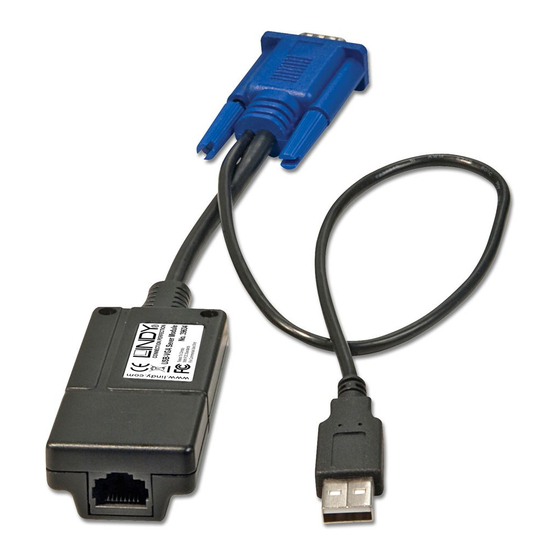Table of Contents
Advertisement
Quick Links
KVM Switch CAT-32 IP
with KVM over IP module slot
User Manual
English
KVM Switch CAT-32 IP: No. 39631
KVM Switch Module for LCD Terminals: No. 39635
www.lindy.com
Tested to comply
with FCC Standards
For Commercial Use Only
© LINDY ELECTRONICS LIMITED & LINDY-ELEKTRONIK GMBH – 3
rd
EDITION (AUG 2014)
Advertisement
Table of Contents

Summary of Contents for Lindy CAT-32 IP
- Page 1 User Manual English KVM Switch CAT-32 IP: No. 39631 KVM Switch Module for LCD Terminals: No. 39635 www.lindy.com Tested to comply with FCC Standards For Commercial Use Only © LINDY ELECTRONICS LIMITED & LINDY-ELEKTRONIK GMBH – 3 EDITION (AUG 2014)
- Page 2 1U height within a 19” rack. The modular version KVM Switch CAT-32 IP has the same features but it does not offer the front panel display and allows the KVM switch to fit into the back of the LINDY LCD Terminal PRO Dual Rail and Classic Single Rail.
-
Page 3: Cat-32 With Ip Access Module
To prevent any hotkey conflicts, please ensure that the KVM hotkeys of the other KVM switches used are not the same as those used on the KVM Switch CAT-32 IP. The KVM hotkeys of the KVM Switch CAT-32 IP can be configured via the OSD. -
Page 4: Product Features
Section 1 Introducing the CAT-32 IP 1.4. Product Features 32 UTP Cat.5/6 server ports in a narrow 1U, 19” rack mount design Dual console operation option: Local console plus a remote console access slot for optional KVM over IP module ... -
Page 5: Optional Cables And Accessories
A Cat.5e or 6 UTP cable of appropriate length (max. 100m) is required to connect the KVM Switch to the computer modules. These cables are available from LINDY in several different colors and lengths from 0.3m up to 100m. We don’t recommend using shielded FTP/STP cables. -
Page 6: Hardware Installation Guide
8 KVM switches with a maximum of 256 servers. 1. Switch off all the computers to be attached. 2. Connect the keyboard, monitor and mouse directly to the ports of the LINDY KVM Switch labelled Local Console. -
Page 7: Kvm Switch Operation
3.1.1. Password Security The KVM Switch CAT-32 IP has a single user password protection with auto logout security. The additional security features for the KVM over IP user are based on SSL and additionally KVM encrypted connections with a further level of password login. -
Page 8: Keyboard Hotkey Selection And Osd Commands
Troubleshooting 3.1.3. Computer / Port Selection You can select the computer you want to access in one of two different ways: Keyboard hotkey selection On screen display menu selection 3.1.4. Illuminated front display, Stand-alone KVM Switch CAT32 only! The front display has a two digit display to show the number of the KVM switch in the cascade: 01: Master, 02: first slave, 03: second slave. -
Page 9: On Screen Display Menu (Osd)
Troubleshooting 3.3. On Screen Display Menu (OSD) The On Screen Display menu provides a lot of information about the switch configuration and the attached computers, and offers advanced administration and full KVM Switch control to the user. Activate the OSD by the hotkey sequence: Scroll Lock + Scroll Lock + space bar Main OSD Menu Select computer/port: use Up/Down Arrow key to... - Page 10 Menu in OSD and adjust the video settings. If this does not help please check the quality of the UTP cable between KVM switch and Computer Access Module. Try replacing the cable, or use a higher quality cable. If you have forgotten the password please contact LINDY.
- Page 11 Check whether the network connection is working in general (ping the IP address of CAT-32 IP). If not, check the network hardware. Is the CAT-32 IP powered on? Check whether the IP address of CAT-32 IP switch and all other IP related settings are correct! Also verify that all the IP infrastructure of your LAN, including routers etc., is correctly configured.
-
Page 12: Fcc Statement
Elektronikprodukten geschaffen. Das deutsche Elektro-Gesetz verbietet das Entsorgen von entsprechenden, auch alten, Elektro- und Elektronikgeräten über die Hausmülltonne! Diese Geräte müssen dem Hersteller (LINDY) oder den lokalen Sammelsystemen bzw. örtlichen Sammelstellen zugeführt werden! Dort werden sie kostenlos entgegen genommen. Die Kosten für den weiteren Recyclingprozess übernehmen die Gerätehersteller.












Need help?
Do you have a question about the CAT-32 IP and is the answer not in the manual?
Questions and answers